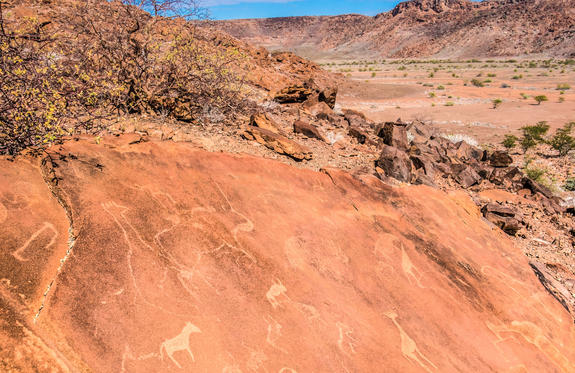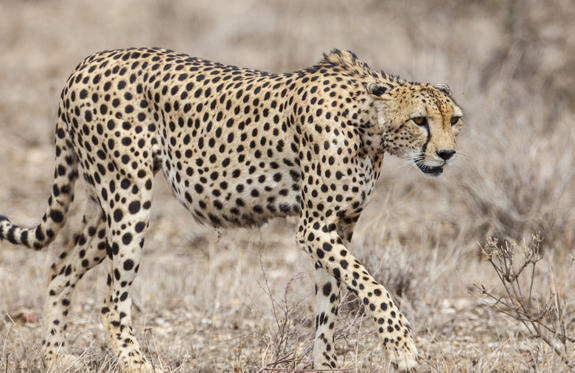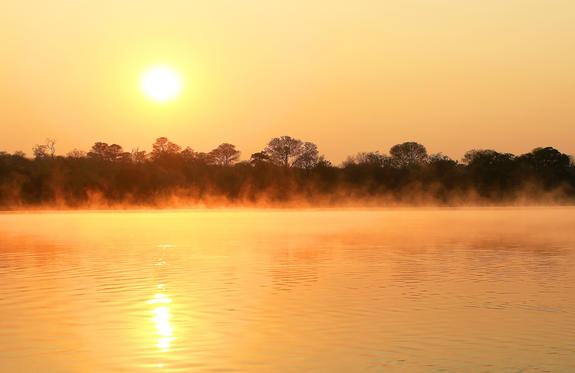Avventura e romanticismo, mix perfetto.
Spazi sconfinati, paesaggi mozzafiato dalle coste al deserto, safari spettacolari al parco Etosha, dove gli animali si alternano alle pozze d'acqua rispettando le gerarchie della fauna di questo meraviglioso paese.
Ed ancora pitture rupestri degli antenati dei San, comunità antichissime come quelle degli Himba, a nord del Paese. Tutto questo è la Namibia, una delle mete più entusiasmanti dell'Africa.
È difficile immaginare come se la siano cavata i colonizzatori tedeschi della Namibia in questi spazi illimitati, con vasti deserti e 300 giorni di sole all'anno, ma sono proprio queste le caratteristiche che oggi attirano i viaggiatori in una delle più affascinanti mete africane. Le attrattive della Namibia, situata tra il Kalahari e il freddo Atlantico meridionale, sono ben note nella circostante Africa meridionale, mentre è solo relativamente da poco che il resto del mondo ha scoperto i suoi deserti, i suoi panorami marini, le sue camminate nella natura, i suoi spazi sconfinati.
Ricca di risorse naturali, dotata di solide e moderne infrastrutture e caratterizzata da differenti culture e tradizioni, la Namibia è un paese affascinante, con grandi potenzialità.
CONOSCERE IL TERRITORIO
La Namibia si trova nell'Africa Australe tra l'Oceano Atlantico ad Ovest, l'Angola a Nord, lo Zambia a Nord-Est, il Botswana ad Est ed il Sudafrica a Sud. Durante l'estate Namibiana la temperatura tocca picchi di oltre 40° sebbene temperature all'ombra abbiano un'escursione fra i 20 e i 34°C durante il giorno. La costa è mitigata dalla corrente fredda del Benguela; la temperatura è abbastanza stabile fra i 15 e i 25°C. Nebbia e foschia sono fenomeni ricorrenti durante la notte. L'inverno va da maggio a settembre. L'escursione termica è notevole in questo periodo dell'anno: si passa da gelate notturne frequenti a temperature che variano dai 18 ai 25°C durante il giorno. La stagione delle piogge va da Gennaio ad Aprile, con precipitazioni intense. È caratterizzata da brevi rovesci e sporadici temporali che ripuliscono l'aria. C'è anche un'altra stagione delle piogge, quella delle "piccole piogge", che va da ottobre a dicembre.

Situata nella Namibia centrale, la città cosmopolita di Windhoek funge da capitale del paese. È sede di un aeroporto internazionale e di una miriade di ristoranti, negozi, luoghi di intrattenimento e opzioni di alloggio. La città è pulita, sicura e ben organizzata, con un'eredità coloniale che si riflette nei suoi numerosi ristoranti e negozi tedeschi e nell'uso diffuso della lingua tedesca. Windhoek vanta un interessante mix di architettura storica ed edifici moderni, molti dei quali meritano un'occhiata, tra cui l'Alte Feste un vecchio forte, la Christuskirche Christ Church del 1896 e la più contemporanea Corte Suprema.

Poiché non ci sono alloggi a Sossusvlei, i visitatori di questa natura desertica finiranno probabilmente per soggiornare a Sesriem, a 65 km di distanza, dove campi e logge fungono da base per esplorare le dune. Sesriem Canyon, un profondo abisso scavato attraverso le rocce dall'acqua, è una caratteristica naturale sorprendente della zona che è meglio esplorare a piedi. Le pareti di pietra si alzano bruscamente su entrambi i lati del canyon, mentre gli uccelli posatano nelle sue falesie e lucertole dardo lungo le sporgenze. Il nome del canyon è stato coniato quando i primi coloni lo usavano come fonte d'acqua, utilizzando sei lunghezze di pelle ("ses riem — sei infradito) legate insieme a secchi inferiori nell'acqua alla base del canyon.)

Situata lungo la costa spettacolare della Namibia, la città balneare di Swakopmund è nota per i suoi viali aperti, l'architettura coloniale e il suo terreno desertico ultraterreno circostante. Fondato nel 1892 come il principale porto dell'Africa sud-occidentale tedesca, Swakopmund viene spesso descritto come più tedesco della Germania. Ora località balneare, Swakopmund è la capitale dell'area turistica della Skeleton Coast e ha molto per rendere felici i visitatori. L'eccentrico mix di influenze tedesche e namibiane, opzioni di avventura, atmosfera rilassata e fresca brezza marina ne fanno una destinazione namibiana molto popolare. I visitatori possono attendere con impazienza una serie di attività entusiasmanti, tra cui: quad, equitazione, parapendio, pesca, visite turistiche e affascinanti tour nel deserto.

Situato nella regione di Kunene, nella Namibia nord-occidentale, il Twyfelfontein è una zona spettacolare, caratterizzata da una delle più grandi e importanti concentrazioni di arte rupestre in Africa. Il nome «Twyfelfontein» si traduce in «Fontana del dubbio», che si riferisce alla sorgente perenne situata nell'imponente valle Huab fiancheggiata dalle pendici di una montagna da tavola in arenaria. È stata questa primavera ad attirare i cacciatori dell'età della pietra più di seimila anni fa, ed è stato durante questo periodo che vennero prodotti il vasto gruppo di incisioni rocciose e dipinti. I visitatori possono non vedere l'ora di basarsi in alcuni campeggi meravigliosamente ombreggiati lungo il letto del fiume Aba-Huab, mentre esplorano oltre trenta diversi siti rituali sacri delle tradizionali comunità di cacciatori-raccoglitori.

Situato appena a sud del confine del Parco Nazionale di Etosha, nel nord-ovest della Namibia, Etosha South costituisce la regione meridionale di questo paradiso selvaggio. L'area è composta da una collezione di riserve di caccia private di livello mondiale. È possibile accedere al parco nazionale tramite l'ingresso sud di Andersson's Gate. I visitatori possono ammirare una varietà di fauna selvatica tra cui: leone, giraffa, elefante, rinoceronte bianco e nero e una moltitudine di selvaggina di pianura. Le attività più popolari includono: godersi un safari all'aperto in 4x4 con una guida esperta, gite di mezza giornata o di un'intera giornata con la possibilità di un pranzo al sacco con vino durante il game drive di una giornata intera.

Confinante con l'Angola, sulle rive del fiume Okavango, nel nord della Namibia, la città di Rundu funge da capitale della regione orientale del Kavango. Rundu è rinomato per il mercato locale degli intagliatori del legno ed è pieno di imponenti laboratori di intagliatori del legno. La città offre un'ottima sosta per fare rifornimento per i visitatori diretti a Katima Mulilo, alle affascinanti cascate di Popa o alla Mahangu Game Reserve, sede del cane selvatico e del leone, del leopardo, dell'elefante, del ghepardo e dell'ippopotamo in via di estinzione. I visitatori di Rundu possono anche godere di un'ottima visione del gioco, di un bird watching eccellente e del kayak sullo spettacolare fiume Kavango.
Il Botswana, con una superficie di 581.000 Km2 e con soli due milioni di abitanti rappresenta una delle terre più incontaminate del pianeta. L’accorta politica turistica adottata dal governo e l’impronta data dai primi esploratori inglesi, ha consentito di mantenere il paese intatto, sfruttando in maniera consapevole e ragionata l’immenso patrimonio naturalistico al suo interno. Il Delta dell’Okavango, al principale attrazione turistica, non accoglie più di 30.000 visitatori l’anno. Il paese, occupato per il 70% dal Deserto del Kalahari, presenta al suo interno diversi ecosistemi, unici e contrastanti: dal paesaggio lunare dei pan nel nord del Kalahari all’oasi acquatica del Delta dell’Okavango, dal verde del Moremi al giallo delle savane del Chobe e del Savute.

Situato nella zona nord-occidentale del delta dell'Okavango, il Panhandle è un tratto del fiume Okavango che segue un percorso più o meno rettilineo per circa 70 chilometri prima di entrare nelle zone umide. Questo canale profondo funge da fonte d'acqua principale che alimenta il delta e offre un'eccellente pesca a tigre e orate, mentre i boschi circostanti e le acque poco profonde del fiume brulicano di una miriade di uccelli. L'Okavango Panhandle è costellato di diversi villaggi e funge da porta d'accesso alle pittoresche colline di Tsodilo, a circa 40 chilometri a ovest, con i loro vari dipinti rupestri tribali, alcuni risalenti a 20 000 anni fa. I visitatori possono godere di un'eccellente pesca, birding di prima classe, andare in barca sul fiume Okavango e ammirare il gioco nel Parco Nazionale di Mahangu.

Nascosto nell'angolo nord-orientale del Botswana, sulle rive del famoso fiume Chobe, la pittoresca cittadina di Kasane si trova alle porte dello spettacolare Parco Nazionale di Chobe. Non ci sono recinti di confine che separano il villaggio dal parco e selvaggina come elefante e ippopotamo sono spesso avvistati in giro per la città. Se siete alla ricerca di gioco sfuggente, visitate la Sedudu Valley Road, dove grandi alberi morti forniscono case temporanee per i leopardi. All'interno di Kasane, si erge un antico albero di baobab, un tempo funge da prigione locale. I visitatori possono godere di una moltitudine di attività tra cui: godersi un giro di gioco attraverso il parco, fare una crociera al tramonto lungo il fiume Chobe, visitare un villaggio locale o saltare in una gita di un giorno alle mozzafiato Victoria Falls.
Nazione di spettacolari bellezze naturali, persone amichevoli e ricca cultura, lo status dello Zimbabwe come una delle principali destinazioni safari in Africa è stato smorzato per anni dalla sua instabilità politica. Ma ora che il paese sta trascendendo le sue lotte e tornando a uno stato di equilibrio, sta ancora una volta emergendo come punto culminante delle vacanze del continente. Victoria Falls, nota alla gente del posto come “The Smoke Thunders”, è una delle sette meraviglie naturali del mondo e la pura potenza di questo massiccio corpo d'acqua che si immerge nella gola dello Zambesi è maestosa e indimenticabile. Il lago Kariba, con le sue coste e le sue isole ricche di selvaggina, è un luogo di safari idilliaco con tramonti mozzafiato; il Parco Nazionale di Hwange è noto per le sue enormi mandrie di elefanti; e una gita in kayak lungo lo Zambesi attraverso il Parco Nazionale di Mana Pools piacerà al viaggiatore intrepido, offrendo incontri ravvicinati con coccodrilli, ippopotami e una miriade di altri animali selvatici.

Conosciute localmente come Mosi-oa-Tunya, «The Smoke That Thunders», le cascate Victoria sono uno dei più grandi monumenti naturali del mondo. A cavallo del fiume Zambezi tra Zambia e Zimbabwe, forma una vasta cortina d'acqua che riempie l'aria di nebbia e suoni. La sponda dello Zimbabwe offre i panorami più spettacolari, dove la nebbia sale come tende spettrali e gli arcobaleni si fanno strada tra gli spruzzi. Con un diametro di circa 1.708 metri, è considerato il più grande strato d'acqua in caduta continua sulla Terra. L'adiacente città di Victoria Falls offre una base conveniente per esplorare la regione, con una vasta gamma di attività, dai voli panoramici e gite in ultraleggero al rafting, al bungee jumping, al kayak e ai safari nel Parco Nazionale del Chobe.




